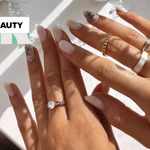We love our natural hair. But, there are times that adequate natural hair care can feel like a full-time job!
Between trying to minimize single strand knots, thinking of ways to shorten the ever laborious wash and conditioning day, and trying to get out of the door to work and other engagements with a style other than your signature puffball, it's normal to feel periods of overwhelm. If you find yourself wanting a quick break from the rituals of natural hair care, heat styling is a viable option. However, heat styling is not without risk - like heat damage. To ensure your hair is as healthy as possible you must prioritize limiting heat damage.
Below are four suggestions for minimizing the risk.

Pre-plan
Before you straighten your hair (on your own or professionally) you want to make sure that you have been practicing effective daily moisturization. Heat damage can come with a lot of long-term complications. And for many of us naturals, it doesn't take much to damage our cuticles or lead to breakage. You can make sure that your hair has what it needs to survive the transition from curly to straight by pre-planning when you're going to straighten your hair. This doesn't mean that you have to plan your appointments three months in advance. But, it would be helpful to spend two to three weeks being extra careful to make sure that your hair is healthy enough for heat.
Daily And Deep Conditioning
Regular moisturization is important. However, more intensive deep conditioning has its place in your routine as well. Regardless of hair type, we can all benefit from daily and deep conditioners that have humectants like honey and glycerin. They work to pull moisture out of the air into our hair cuticles. The best way to deep condition your hair depends on your hair type. For example, individuals like myself, who have low porosity hair, will do best when using heat or steam in their moisturizing efforts. Otherwise, our hair might not be receptive to the nutrients we are trying to offer. When you combine your daily and deep conditioning routine, you'll get moisturized hair and it will be visible in your hair's elasticity. That increased elasticity makes your hair less prone to the breakage and potential stress that comes with hair straightening.

Protein Treatments
Before heat straightening, you probably want a protein treatment. Protein treatments offer assistance to damaged hair by adding small deposits to fill out gaps in the hair cuticle. When your hair has a reasonable balance of protein, it improves the appearance of your hair and often the overall strength. However, remember that there are plenty of individuals who have skin and hair that is considered protein sensitive. A sign of protein sensitive hair or protein overuse is a dry/crunchy feeling in your hair post protein treatment.
Protective Styling
When our hair is curly, we aim to do as many protective styles as possible. But did you know that you can also wear protective styles while your hair is straightened? Protective styling is useful whether your hair is in its curly state or under the influence of heat. Straight hair does not have to mean that you wear the same wrap or flat ironed style each day. Nearly all of the styles that are available to you when wearing your hair curly are possible with a slight adjustment when you are wearing your hair straight (as long as it doesn't involve water). Buns, plaits, and the use of rollers are all great options for straightened hair! Protective styling on natural hair helps to diversify your styling options; it also reduces the need to straighten your hair regularly. Remember that the more frequently you straighten your hair, the higher the likelihood you will get heat damage.
So, when your hair gets to that “awkward not-so-straight-anymore” stage, it’s ok to embrace stretched hair and be as creative as you can.







